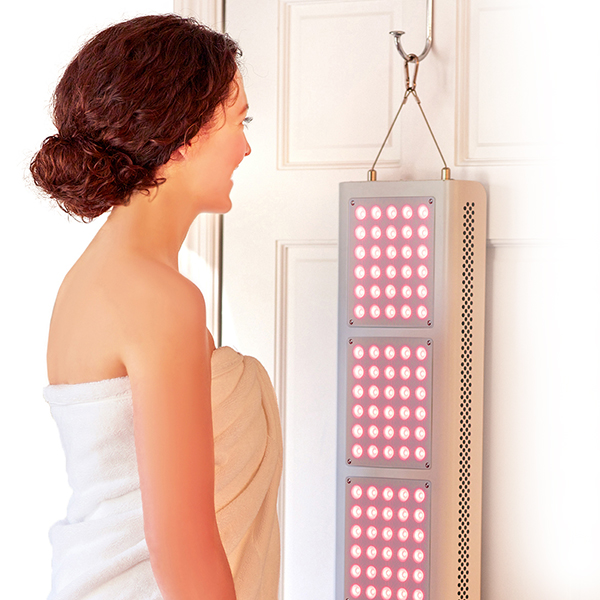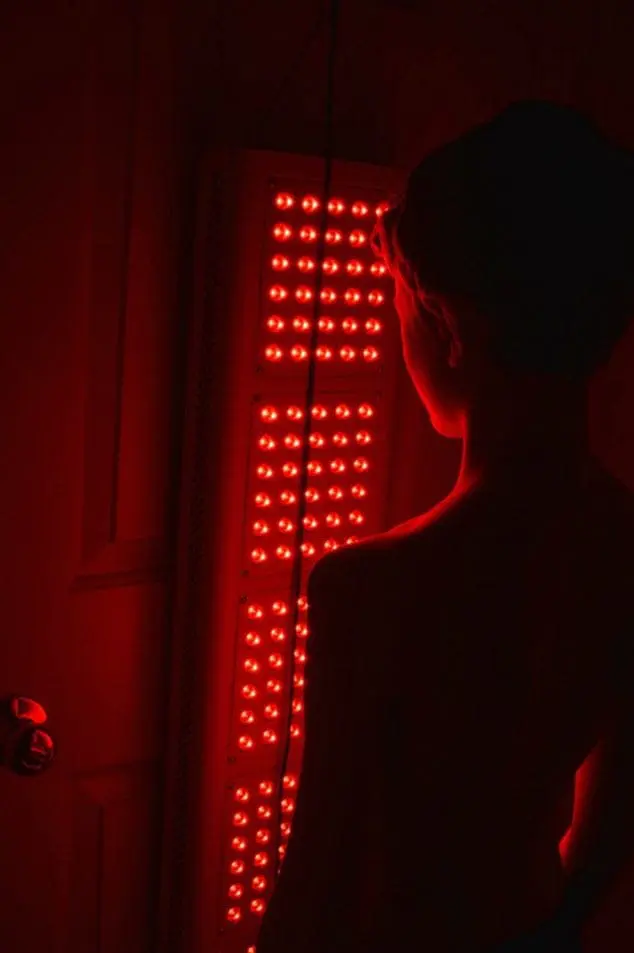So have you heard of Red Light Therapy? Wondering what it is or want to learn more? Red light therapy benefits are thought to be quite numerous and many consider it to be a healthy lifestyle choice. I aim to answer all your Red Light Therapy questions. I’ll start with the basics and answer, “What is red light therapy?” Then, I will move on to red light therapy benefits and finally I will address red light therapy devices and how to chose the right one for you. I was provided with a red light therapy device by the folks at JOOVV in order to facilitate my review.
“What is red light therapy?”
Red light therapy is also known as LED (light-emitting diode) photomodulation or LLLT (low-level light therapy) and it is the use of exposure to red LED lights. Red light therapy delivers a specific light wavelength (with no UV rays) which can penetrate deep into your body and deliver red light energy to the body.
Most at-home and salon red light therapy treatments offer generalized, light box therapy. The treatment of targeted specific areas with red light therapy is usually reserved for doctors’ and skin care specialists’ offices. LED Red Light Therapy is an FDA-approved cosmetic procedure that is gentle, painless, safe and effective.
If you are questioning whether a light can actually produce any effect on the body, don’t. Think about it, you already know that exposure to sunlight causes your body to produce vitamin D. Want another example? In the 19th Century, a Nobel Prize was awarded to Dr. Niels Finsen, a Danish Physician who demonstrated the beneficial effects of various wavelengths in the treatment of tuberculosis.
Research into red light therapy, how it works and what it can do, has been going on for at least 40 years and it has been touted for its many benefits ranging from wound healing to reduction of fine lines. I will get into some of the Red Light Therapy Benefits and supporting medical research below.
Benefits Of Red Light Therapy
The first information I read on red light therapy benefits centered around multiple benefits for the skin from acne reduction to wrinkle reduction.
Before I say any more on Red Light Therapy Benefits, I’d like to make clear that he information on this site is not intended or implied to be a substitute for professional medical advice, diagnosis or treatment. Please DO consult with a qualified physician if you have any medical concerns.
Red Light Therapy For Skin
There is no doubt about it. Red light therapy is good for skin rejuvenation in multiples ways. When you read this next bit from a research paper, you will doubtlessly be inspired by the possibilities. I know I was.
“The photons are absorbed by mitochondrial chromophores in skin cells. Consequently electron transport, adenosine triphosphate (ATP) nitric oxide release, blood flow, reactive oxygen species increase and diverse signaling pathways get activated. Stem cells can be activated allowing increased tissue repair and healing. In dermatology, LLLT has beneficial effects on wrinkles, acne scars, hypertrophic scars, and healing of burns. LLLT can reduce UV damage both as a treatment and as a prophylaxis. In pigmentary disorders such as vitiligo, LLLT can increase pigmentation by stimulating melanocyte proliferation and reduce depigmentation by inhibiting autoimmunity. Inflammatory diseases such as psoriasis and acne can also benefit. The non-invasive nature and almost complete absence of side-effects encourages further testing in dermatology. –NCBI 8/2014
Red Light Therapy For Wrinkles
“The treated subjects experienced significantly improved skin complexion and skin feeling, profilometrically assessed skin roughness, and ultrasonographically measured collagen density. The blinded clinical evaluation of photographs confirmed significant improvement in the intervention groups compared with the control.” –NCBI 2/2014
Red Light Therapy For Acne
“Clinical trials show that 85% of the patients demonstrate a significant quantitative reduction in at least 50% of the lesions after four biweekly treatments. In approximately 20% of the cases, acne eradication may reach 90%. At 3 months after the last treatment, clearance is approximately 70% to 80%. The nonrespondent rate is 15% to 20%.” NCBI 2/2004
Red Light Therapy For Vitiligo
This one is personal. My son is part of the 1% of the population that has Vitiligo, a pigmentary disorder characterized by depigmentation of the skin and hair. The doctor offered me a steroid cream and a tiny pamphlet that basically said they wasn’t much they could do if the cream didn’t work. So for six years, I have watched as the depigmentation spreads and I have wondered if there is something I could do. Well, when I read about red light for the skin rejuvenation, I wondered if there was any chance it could help my son’s skin. A little research in the medical database turned up that studies already exists suggesting it efficacy. That’s the good news. The bad news, is it takes awhile. But hey, I am more than willing to give it time because time passes anyway.
“…after 6–8 months of treating 18 vitiglio patients with low-energy HeNe laser (632 nm, 25 mW/cm2 ) therapy, marked repigmentation was observed in 64% of the patients and some follicular repigmentation was observed in the remaining 34%.” NCBI 12/1997
I even found research on Red Light Therapy Benefits beyond skin rejuvenation.
Red Light Therapy For Pain & Wound Healing
Among the clinical applications, non-healing wounds can be healed through restoring the collagenesis/collagenase imbalance in such examples, and ‘normal’ wounds heal faster and better. Pain, including postoperative pain, postoperative edema and many types of inflammation can be significantly reduced. NCBI 3/2011
Red Light Therapy Depression
“In this study, we have demonstrated a modest improvement of Seasonal Affective Disorder (SAD) depression symptoms after a single light session.” NCBI 3/2017
“Light therapy for non-seasonal depression: The overall quality of evidence is poor due to high risk of bias and inconsistency. However, considering that light therapy has minimal side-effects and our meta-analysis demonstrated that a significant proportion of patients achieved a clinically significant response, light therapy may be effective for patients with non-seasonal depression and can be a helpful additional therapeutic intervention for depression.” NCBI 3/2016
Red Light Therapy For Weight Loss
Red light therapy, also known as low-level laser therapy (LLLT) or photobiomodulation (PBM), has gained attention for its potential benefits across various health and wellness areas, including weight loss. While it’s not a direct method for weight loss like diet or exercise, some studies and anecdotal evidence suggest that red light therapy may indirectly support weight management through several mechanisms:
- Increased Metabolism: Red light therapy may stimulate the mitochondria in cells, enhancing cellular energy production. This boost in cellular activity could potentially lead to an increase in metabolism, assisting in burning more calories.
- Fat Reduction: Some research indicates that red light therapy might help in reducing fat, particularly subcutaneous fat (fat located just beneath the skin). This process involves stimulating adipocytes (fat cells) to release their contents, which the body can then process and eliminate.
- Improved Circulation: Red light therapy has been suggested to improve blood circulation and lymphatic system function. Enhanced circulation could assist in delivering oxygen and nutrients to tissues more efficiently, potentially aiding in fat metabolism and overall body function.
- Reduction in Inflammation: Chronic inflammation is linked to obesity and metabolic syndrome. Red light therapy has shown promise in reducing inflammation, which could indirectly support weight management efforts.
- Enhanced Exercise Performance: Some studies suggest that red light therapy may help in reducing muscle fatigue and improving exercise performance. By potentially allowing individuals to exercise more effectively and for longer durations, it can indirectly contribute to weight loss efforts.
It’s important to note that while some research and anecdotal evidence support these potential benefits, the efficacy of red light therapy for weight loss is not fully established. Results may vary among individuals, and more robust clinical trials are needed to validate these claims conclusively.
As you can see red light therapy benefits are quite varied and promising.
How about Red Light Therapy Risks?
There are very few possible side effects, however, light therapy may trigger mania in some people with bipolar disorder, so get advice from your doctor before starting light therapy. You can read more on the risks here. The information on this site is not intended or implied to be a substitute for professional medical advice, diagnosis or treatment. Please DO consult with a qualified physician if you have any medical concerns.
My JOOVV Review of Red Light Therapy Devices
If you have decided that you are interested in Red Light Therapy Benefits and that it can work for you the next step is getting a red light therapy device. Now this part is super important. To see results the red light therapy system must have the correct wavelength for the target cells, deliver an appropriate power density and have an adequate energy density.
Now, I myself, found the JOOVV website’s guide to choosing a red light therapy device incredibly informative and useful. I was a biology major so I like their scientific explanation of the most effective wavelength and the amount of energy delivered to your cells in Joules/cm2.
JOOVV offers 3 different sized Red Light Therapy Devices. This allows you can pick the one that is right for your needs and budget. The JOOVV unit comes with an over the door hook. It also has a simple pulley attachment so it can easily be raised or lowered. You can take it out of the box and hang it up and turn it on for a treatment about 2 minutes after you get it! So easy to use. You can find out more, read testimonials or order at joovv.com.
Conclusion
The use of red light therapy as a noninvasive treatment has gained popularity thanks to promising clinical research and a growing review of studies highlighting its potential to enhance cellular function and support ATP production within the body’s cells. While in-office treatments were once the norm, the rise of at-home red-light devices like those from JOOVV has made this new treatment more accessible than ever. These devices offer the convenience of professional-grade therapy from home, making it easier to incorporate red light therapy into daily wellness routines.
In conclusion, red light therapy offers a range of potential benefits—from promoting skin health and reducing inflammation to supporting muscle recovery and overall wellness. JOOVV stands out in the market for its high-quality, FDA-cleared devices that combine advanced technology with user-friendly features. Whether you’re new to red light therapy or looking to upgrade your current setup, JOOVV provides a reliable and effective option to help you reach your health and wellness goals from the comfort of home.
So have you heard of right light therapy before? Which of the red light therapy benefits appeals to you the most?
Related Posts:
About Family Counseling Services [Types And Benefits]



